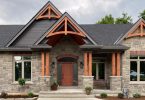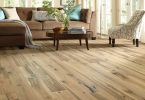 Text by Heather Leask Armstrong
Text by Heather Leask Armstrong
Geothermal energy is based on an idea that dates back to when the Romans used the natural energy in the earth to heat their baths. In fact, there is evidence that even earlier people used the heat escaping from the earth to heat their food.
Today, heating and cooling your home with geothermal energy makes sense for your pocket book and for the environment.
Also known as ground-source heat pumps, today’s geothermal systems take advantage of the earth’s constant temperature of approximately 55°F to heat and cool a building.
Although developed as early as the 1940’s, the first ground source heat pump systems were expensive and required large areas of land for installation, limiting their use to commercial applications.
During the last several years, however, rising fossil fuel costs have prompted manufacturers to refine geothermal technology. Today equipment is more efficient, less costly, and more easily installed, making geothermal a viable heating and cooling option for home owners.
Because geothermal systems move heat that already exists in the form of renewable energy from the ground rather than burning something to create heat, they reduce the amount of toxic emissions in the atmosphere. As the system doesn’t rely on outside air, it keeps the air inside of buildings cleaner and free from pollens, outdoor pollutants, mold spores, and other allergens. These qualities have earned geothermal the label of being “the most energy-efficient and environmentally sensitive of all space conditioning systems” by the U.S. Environmental Protection Agency. Natural Resources Canada has participated in endorsing geothermal technology as well as having just concluded a three year agreement to help promote the technology with the International Ground Source Heat Pump Association (IGSHPA).
According to the IGSHPA, ground source heat pump systems are 50 to 70 percent more energy efficient than other heating systems and offer cooling at a rate 20 to 40 percent more efficient than available air conditioners.
The result is a reduction in energy costs of 60 percent or more. Provincial utilities are also encouraging residents to take advantage of geothermal energy. Manitoba Hydro, for example, offers Residential Earth Power Loans of up to $15,000 for geothermal installations.
A variety of geothermal options are available to home owners. In general, here is how the system works:
The heat pump system is located in your home and, on the surface looks much like a regular furnace and air conditioning system.
Pipes made out of strong polyethylene plastic and containing an environmentally friendly heat transfer solution (generally water or an anti-freeze like solution) are buried outside in the ground or placed in a well, lake or pond.
In the winter, the solution in the pipes absorbs heat from the ground or water and brings it back to the building. There, the heat pump uses electrically-driven compressors and heat exchangers in a vapor compression cycle – the same principle used in a refrigerator – to concentrate the earth’s energy and release it inside the building at a higher temperature. In a typical system, a duct fan system then distributes the heat to various rooms. For installations in older buildings, usually the existing ductwork can be used or slightly modified. Water to water systems are also available that negate the need for a ducting system and can be used for radiant in-floor heating.
To cool the building in summer, the process is reversed. Excess heat is drawn from the building, expelled to the loop system and absorbed by the earth. Like a refrigerator keeping the contents inside cool, the system provides cooling by withdrawing heat, not by injecting cold air.
The piping system can be either an open system or closed loop. An open system takes advantage of the heat retained in an underground body of water and draws the water up through a well directly to the heat exchanger, where the heat is extracted. The water is then discharged either to an above-ground body of water, such as a stream or pond, or back to the underground water body through a separate well.
For a closed loop system, the pipes can be laid out horizontally in trenches (called a horizontal closed loop system), positioned on the floor of a body of water and weighted down to avoid shifting caused by spring ice movement (called a closed loop lake or pond loop), or bored into vertical holes in the ground (called a vertical closed loop system).
When choosing the right system for your home, the best approach is to talk to a local contractor with several years experience in geothermal installation to discuss your heating and cooling needs and the size of system you will require. The contractor will also discuss the best option for installing the pipe system based on your soil type, space limitations and whether or not you already have a well or pond.
Soon Manitobans will be able to find a specialist in their area suited to their needs through a new Manitoba geothermal association. The association which will provide a list of member contractors and feature a rating system and the association hopes to be set up to register members by the end of this year.
Depending on the size of your home and soil type, the cost of a ground source heat pump unit at about $10,000 with installation for either a well or loop system at about $5,000. The well system is particularly suited to homes and farms in south eastern Manitoba. In addition to reducing the amount of digging and resulting “mess” in the yard while you wait for the ground to settle, the well system can provide up to 20 per- cent greater efficiency over a loop system.
Based on current energy rates, residents can expect to recoup their initial geothermal expenditure through energy savings in 8-10 years or, using the Manitoba Hydro Residential Earth Power Loan, in about 15 years. You can sign up for the loan program through your local contractor. There is more information about the Manitoba Hydro loan program and about heat pumps on the Manitoba Hydro website (www.hydro.mb.ca). The website notes that in some cases your heat pump may save more on your energy bill than your monthly payment on the Earth Power loan, making the loan pay for itself.
As a homeowner who enjoys the energy savings and environmental friendliness of a geothermal system, I can also list some other benefits. One of the first things you will notice is there are no longer hot or cold spots in the house. An even comfort level is created because the air is moved in slightly higher volumes, eliminating the hot or cold air blasts common with other systems. Excess heat collected can be used to heat your hot water heater, resulting in free hot water in the summer and substantial hot water savings in the winter.
Typical heat pump units are guaranteed for 25 years with the loop or heat collection system guaranteed for 50 years, so the extra initial cost over traditional heating and cooling systems can be realized back in reduced future equipment and repair costs as well as in greater efficiency.
A typical system can supply 80 to 100 percent of your heating load even in northern climates. The IGSHP website points out that sizing the system to handle your entire heating needs may result in slightly lower heating costs, but the savings may not offset the added total of the larger system. Your local contractor can carry out a heating and cooling load calculation to determine the best sized system for your needs.
Latest posts by Canadian Home Trends (see all)
- Layer Up – Wrap Your Bathroom In Light - December 14, 2025
- The Power of Rest: Elevate Your Wellness with Better Sleep - December 14, 2025
- VERSATILE KITCHEN DESIGN - December 14, 2025







It says “residents can expect to recoup their initial geothermal expenditure through energy savings in 8-10 years ” but with the tax credits available, the cost can be recovered much sooner than that now.
I would like to know if there is some kind of credit or grant from the Govt. for those who have already installed a Geothermal system in a new home within the last 3 yrs. With all the talk about “going green”, seems to me there could be some compensation for the added additional cost of the Geo system.
Anyone out there who may know?
KH
Thank you for your question. Yes – there are government programs that will help compensate for the cost. The federal ecoENERGY Retrofit – Homes Program will cover up to $4,375 of the cost when you replace your existing heating system with a geothermal system.
You can find information on eligibility and application process here:
http://oee.nrcan.gc.ca/residential/personal/grants.cfm?attr=4